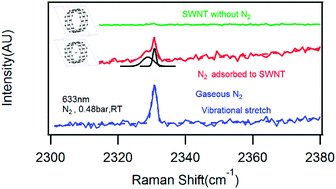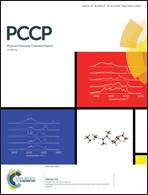In situ vibrational spectroscopy of adsorbed nitrogen in porous carbon materials†
Abstract
This study uses in situ vibrational spectroscopy to probe nitrogen adsorption to porous carbon materials, including single-wall carbon nanotubes and Maxsorb super-activated carbon, demonstrating how the nitrogen Raman stretch mode is perturbed by adsorption. In all porous carbon samples upon N2 physisorption in the mesopore filling regime, the N2 Raman mode downshifts by ∼2 cm−1, a downshift comparable to liquid N2. The relative intensity of this mode increases as pressure is increased to saturation, and trends in the relative intensity parallel the volumetric gas adsorption isotherm. This mode with ∼2 cm−1 downshift is thus attributed to perturbations arising due to N2–N2 interactions in a condensed film. The mode is also observed for the activated carbon at 298 K, and the relative intensity once again parallels the gas adsorption isotherm. For select samples, a mode with a stronger downshift (>4 cm−1) is observed, and the stronger downshift is attributed to stronger N2–carbon surface interactions. Simulations for a N2 surface film support peak assignments. These results suggest that N2 vibrational spectroscopy could provide an indication of the presence or absence of porosity for very small quantities of samples.



 Please wait while we load your content...
Please wait while we load your content...